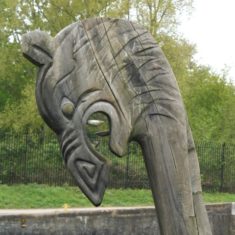Lee Valley Park Sculpture Trail (South)
Colin Wilson
The Sculpture Trail in the Lee Valley Regional Park was set up in 2012 for the Olympic Games. The closest stations to the Whitewater centre are Cheshunt and Waltham Cross. A trail of sculpture artworks was set up between Cheshunt and Waltham Abbey, also extending to the north of Cheshunt. The history, ecology and wildlife of the area provided the inspiration for the various sculptures. Maps and information boards are located at the sites. This article describes those to the south of Cheshunt station; those to the east and north are described in another article.
It is appropriate to add that the attached photos were taken in April 2020 during the lockdown caused by the Covid-19 pandemic. A number of sculptures were taped off to stop people using them.
Starting at Cheshunt station, you head towards the Lee Navigation and turn right into the car park. This takes you to the first group. It was the original natural play area which comprises Earth, Fire, Wind and Water, the classical four elements. The information board shows it as The Henge. Some fallen trees resemble megaliths. A number have images carved on them, and a couple have been shaped to make benches. Looking through the wooden arch (depicting the final standing part of the henge) you enter the
The henge is Earth. Fire is a fairly minimalistic group of uprights reaching for the sky. Wind consists of a sort of circle reminiscent of sites such as Stonehenge, along with 5 logs and the trees themselves moving in the breeze. The uprights forming the circle are assorted shapes, some being carved into fish tails. In the centre is a broken tree trunk. Could this be a broken altar stone? At the far end five logs lay flat on the ground. Two are carved, one as a swan, the other as a female figure. Two are part carved. A wooden frog on a branch provides the entrance to Water. Dragonflies and Damsel flies emerged onto branches. In the glade area the centrepiece was something like a totem pole with a female figure at the top. Various tree trunks rising from the ground were carved into fish-like images.
Continuing south along the path led to The Giant’s Chair. As the name suggests, it was a substantial structure. Passing that and turning left at the next junction revealed The Shrine. My first reaction was to think of the Easter Island statues, but in fact it’s inspired by the Green Man. If you look there are two further figures hidden in the carved foliage. The back of the statue has a chair carved into it, for storytellers to use. The listeners are provided with two beautifully carved seats.
Reaching the lock you cross the water and have a pleasant walk along the path, heading eastwards. After passing a pill-box (a relic from wartime) you find The Banded Demoiselle. It’s simply a damsel fly on a water lily. But it rewards a good look. The light makes an enormous difference. When the evening sun catches the insect it has a gorgeous lustre, like mother of pearl. The leaves have interesting patterns on them. We are not talking of a natural wood sculpture this time, but metallic.
But we have to return to the lock then head south along the towpath towards Waltham Abbey. Slightly hidden near the bridge is a sculpture called Musicality. It’s a giant xylophone made from branches, meant to be played. Next to it can be found a three-sided bird sculpture, labelled as a Murder of Crows. It has that menacing feeling to it.
It’s not far now to Waltham Abbey. Just before the main road are the skeletal remains of a Viking ship, denoting the ancient boundary between Wessex and the Danelaw. The story goes that Alfred diverted the course of the river, stranding a ship. While (subjectively) the ship seems smaller and less awe-inspiring than expected, this may well be because many photographers use wide angle lenses for effect. But just look at the basic simplicity of the design and admire the beautiful carving on the dragon’s head.
Anyway, it‘s time to head off back. There are plenty of alternative routes, and they’re rather interesting. Just make sure to keep your eyes and ears open. There’s plenty to enjoy apart from the sculptures.
For further information please see visitleevalley.org.uk
There are of course various other possible routes. Take a look at https://www.visitleevalley.org.uk/en/content/cms/outdoors/walks-walking/walking-routes/ware-to-waltham-abbey/artworks-route-one/, https://www.visitleevalley.org.uk/en/content/cms/outdoors/walks-walking/walking-routes/ware-to-waltham-abbey/artworks-route-two/ and https://www.visitleevalley.org.uk/en/content/cms/outdoors/walks-walking/walking-routes/ware-to-waltham-abbey/artworks-route-three/. These pages contain links from which route maps can be downloaded.


























Add your comment about this page